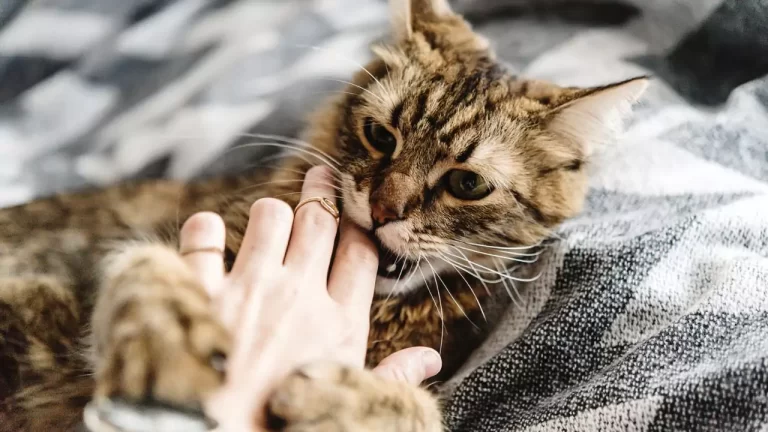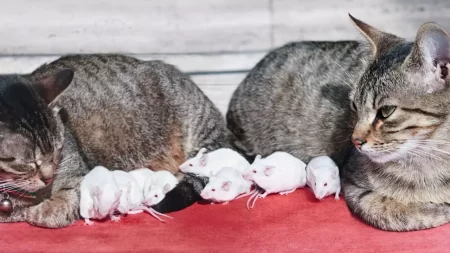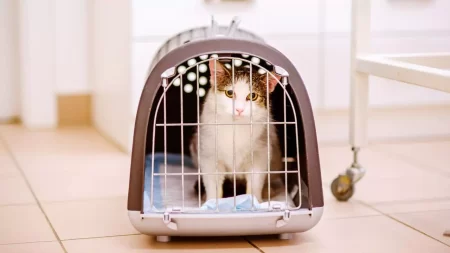Yes, cats do bite. Cat biting is a natural feline behavior, though the reasons and motivations behind it can vary. While nips and nibbles are often harmless, cat bites can sometimes lead to injuries or infections that require medical treatment.
Understanding the causes of cat bites and learning how to curb biting behavior is key to promoting harmony between cats and their human companions.
Reasons Why Cats Bite
There are several explanations for why cats bite. Some cat bites are playful and affectionate, while others stem from stress, fear, or aggression. Common motivations include:
Play Biting
Kittens and younger cats often bite while playing. Play-biting allows them to practice hunting techniques and interact socially with other cats. However, their sharp teeth can accidentally break the skin. Kittens may need to learn bite inhibition when playing with humans.
Love Biting
Cats sometimes gently nip to show affection. Love bites are typically inhibited – the teeth just barely graze the skin. Cats may aim love bites at the hands or ankles of a favored human.
Biting for Attention
Biting can be an attempt to get a human’s attention. Cats who feel ignored may resort to nipping or nibbling to prompt desired actions like petting, feeding, or playing. This biting stems from a need for stimulation and interaction.
Overstimulation or Anxiety
Too much petting or handling can overstimulate a cat, even if it seems to enjoy human touch initially. An overwhelmed cat may bite or scratch to get the interaction to stop. Anxiety, stress, or fear can also cause defensive biting.
Kitten Biting or Teething
Young kittens teethe as they lose baby teeth around 3-6 months old. Kittens may bite and chew on hands, wires, furniture, or ankles as they seek relief from sore gums. Teething kittens need access to appropriate chew toys.
How to Stop Cat Biting?
While some cat biting is inevitable, there are strategies to curb excessive nipping, chewing, or biting that arises from play, boredom, or aggression:
Recognizing Signs of Aggression
Learn your cat’s body language to identify signs of overstimulation or aggression before biting occurs. Warning signs include a flickering tail, turned ears, tense muscles, and widened eyes.
Redirecting Behavior
Distract a playful biter with an engaging toy to shift its focus to appropriate outlets for hunting, pouncing, and chewing. Interactive toys that mimic prey work best.
Providing Appropriate Outlets for Play
Ensure your cat has sufficient outlets for natural play behaviors. Provide puzzle toys, scratching posts, interactive play sessions, and enrichment to prevent boredom that leads to biting.
Using Deterrents
Respond to unwanted biting by firmly saying “no,” withdrawing attention, or using deterrents like bitter apple spray on hands and ankles. Avoid physically punishing cats, as this increases anxiety and aggression.
Seeking Professional Help if Needed
For cats exhibiting frequent, unprovoked aggression, consult your vet and an animal behaviorist. Medication or behavior modification plans may be needed in some cases.
What to Do If Your Cat Bites You?
Even well-meaning cats may occasionally nip or break skin while playing. If your cat bites you, take these steps:
Clean the Wound
Immediately wash bite wounds with soap and warm water. Rinse thoroughly to remove bacteria and decrease infection risk. Rubbing alcohol can disinfect wounds after cleaning.
Observe for Signs of Infection
Monitor bites for redness, swelling, warmth, pus, or streaks over the next 24 hours. These signal a possible skin infection requiring medical treatment.
Seek Medical Attention if Necessary
Consult your doctor for deep punctures, bites on the hand, face, or joints, or signs of infection like fever or pus. Antibiotics may be prescribed to prevent bacterial complications.
Reflect on the Situation and Address Any Underlying Issues
Consider what prompted the bite – was it play that got too rough? Fear? A need for more stimulation? Work on solutions like more playtime or calming anxieties to prevent future biting incidents.
In summary, cat bites are common but can usually be managed with training, routine health checks, proper play and enrichment, and medical care if needed. Paying attention to your cat’s behavior provides the key clues to avoiding unwelcome biting while keeping your feline friend happy and healthy.







